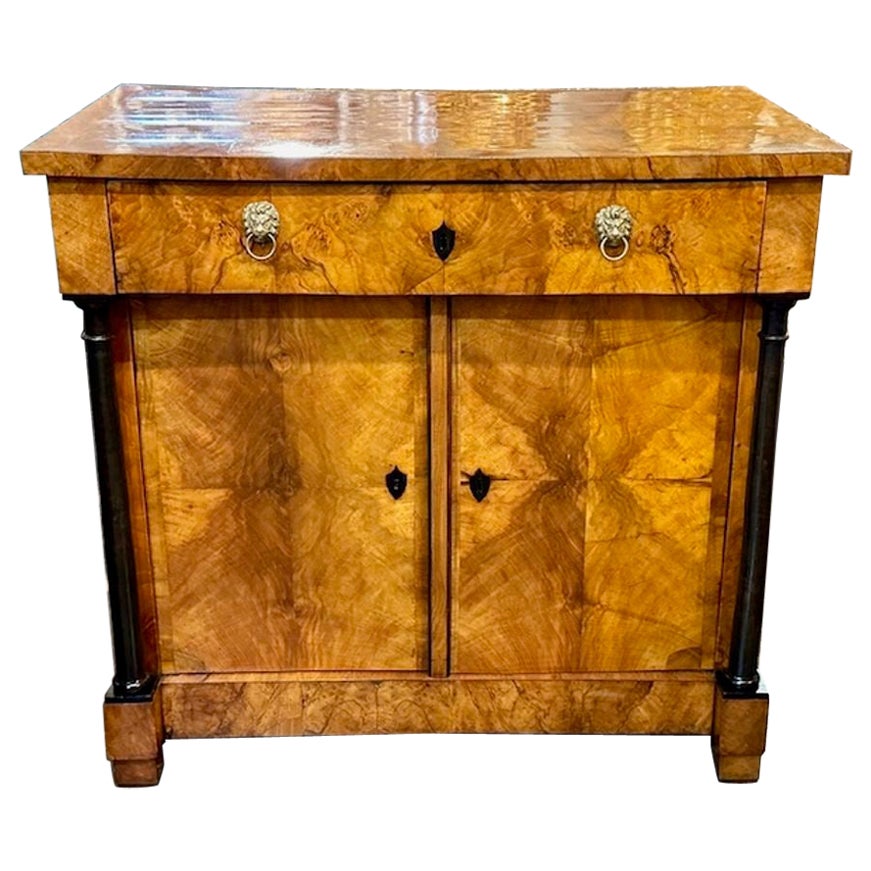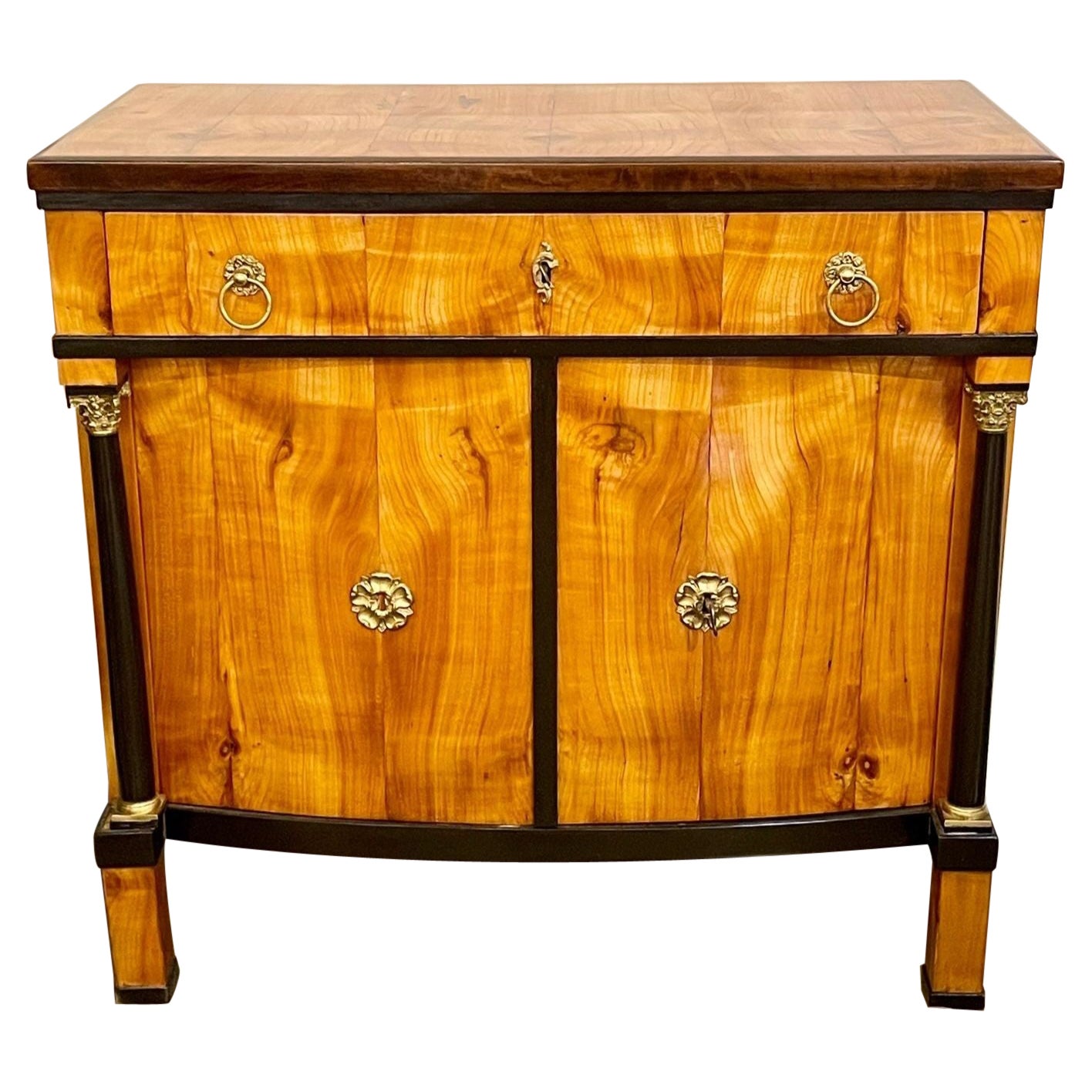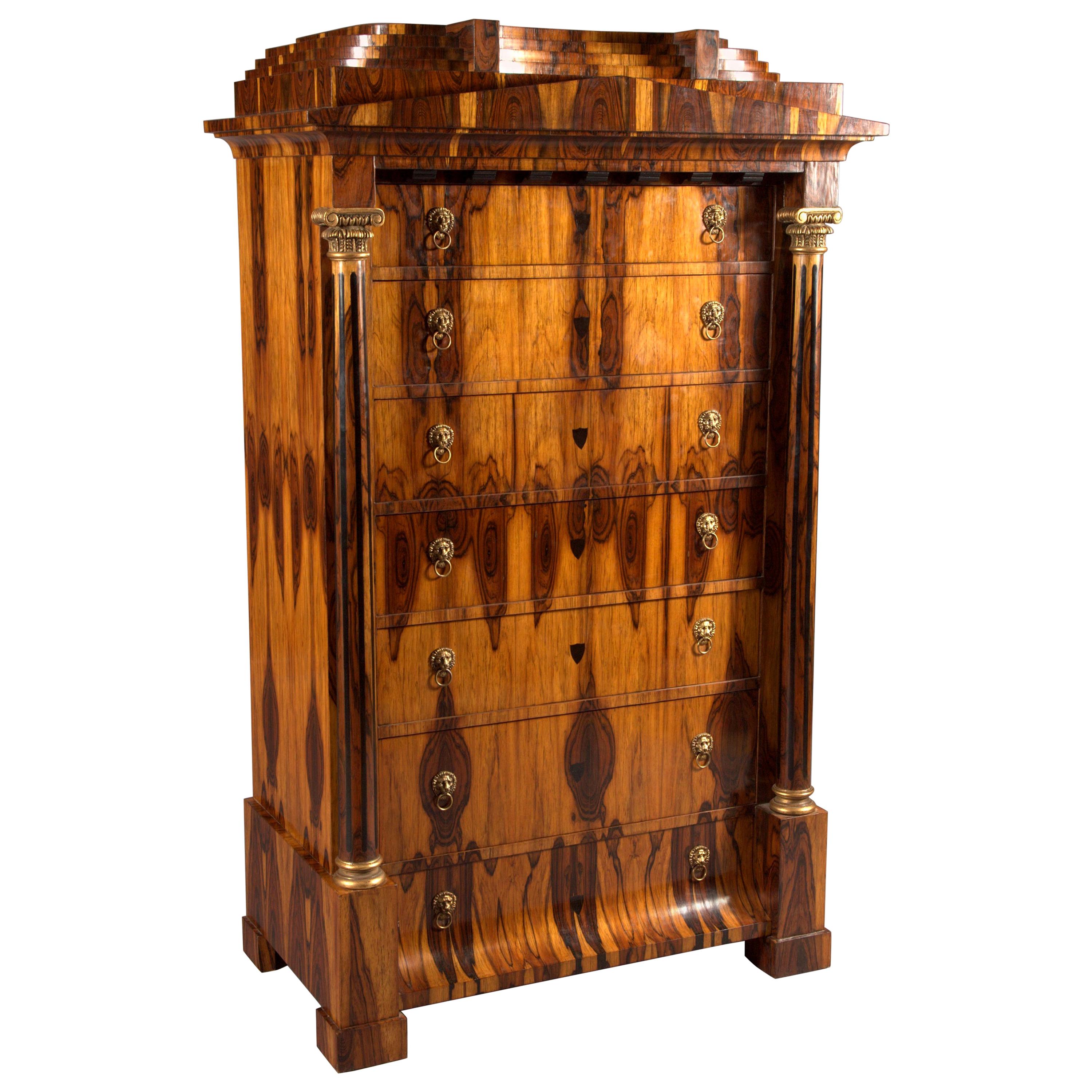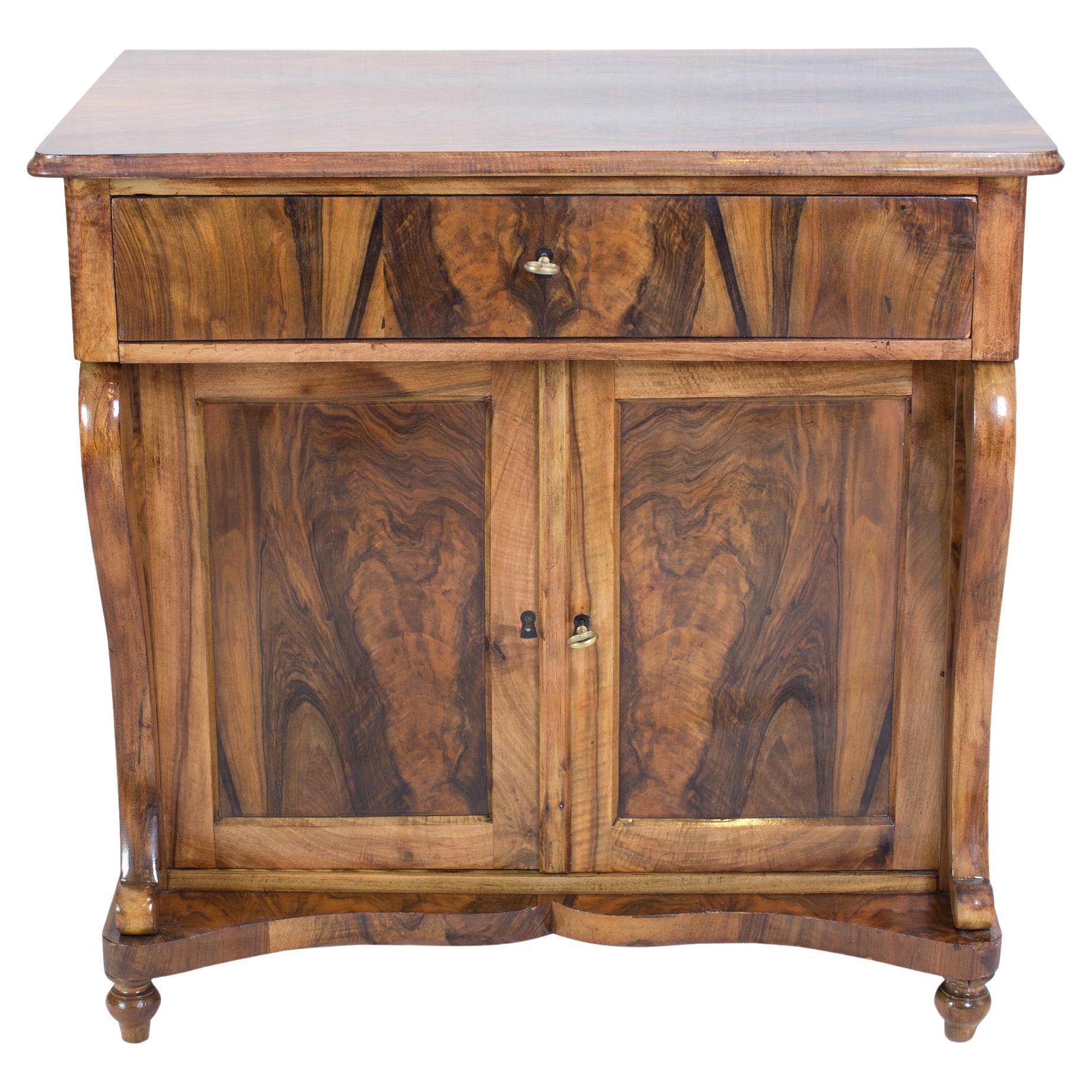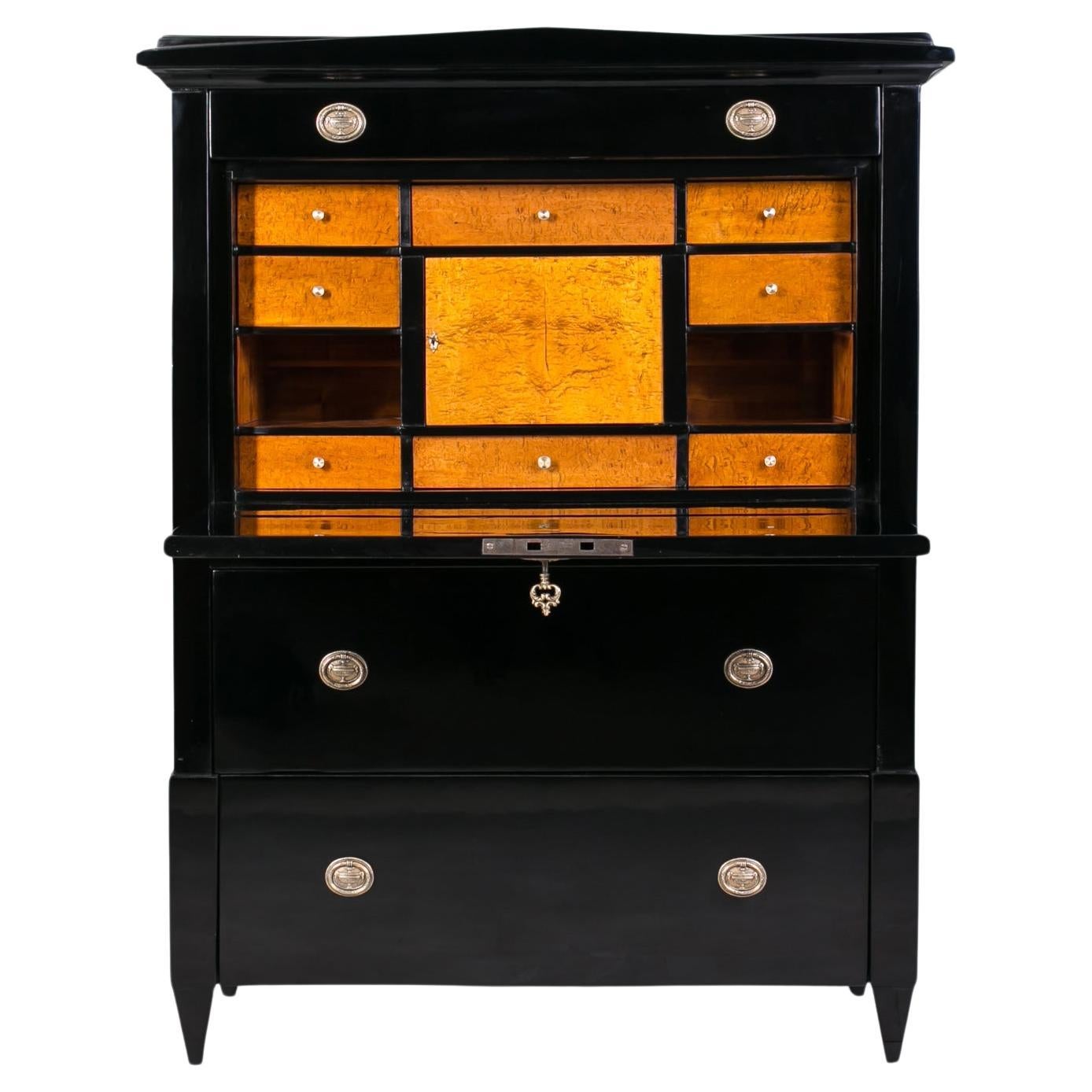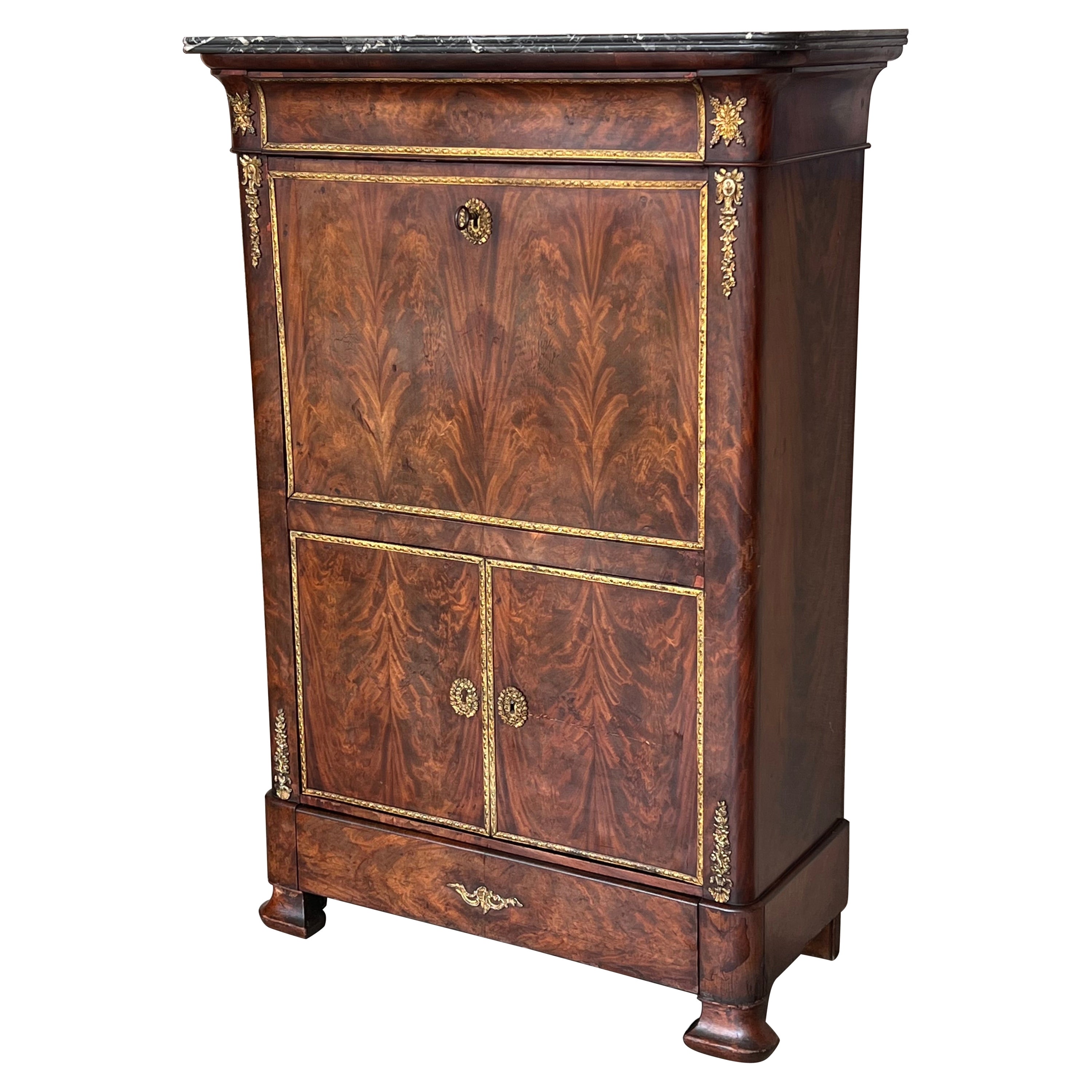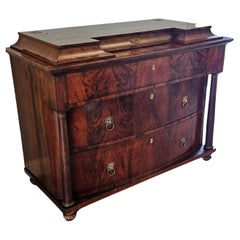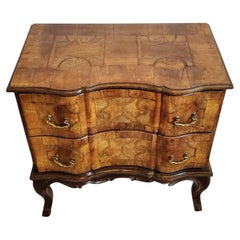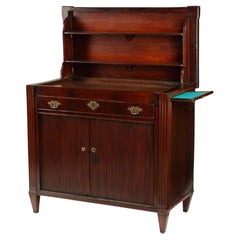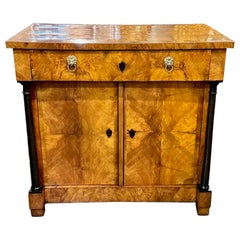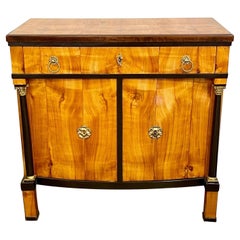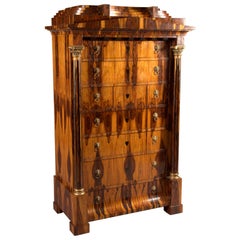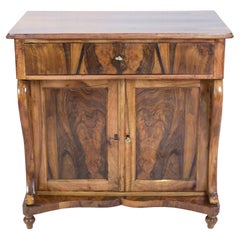Items Similar to Biedermeier Period Burlwood Table Cabinet Of Curiosities Wunderkammer 19th C.
Want more images or videos?
Request additional images or videos from the seller
1 of 21
Biedermeier Period Burlwood Table Cabinet Of Curiosities Wunderkammer 19th C.
$8,500
£6,488.56
€7,459.04
CA$11,961.02
A$13,301.15
CHF 6,986.05
MX$162,619.90
NOK 87,052.90
SEK 82,067.38
DKK 55,668.51
About the Item
A fine Biedermeier Period (1815-1848) walnut maple burlwood marquetry table cabinet - wunderkammer (cabinet of curiosities) with fifteen drawers and concealed secret compartments, circa 1820.
This architectural curiosity cabinet is a testament to the ingenuity and artistry of European craftsmen from the early 19th century. The highly figured quilted wood grain, warm rich burled walnut panels, and hand sculpted and molded ebonized wood exterior boasts a dark, lustrous sheen, while delicate hand carved details adorn its surface, showcasing the finesse and precision of its creator.
Probably Southern Germany, most likely Augsburg, having a rectangular raised top with visible hand cut dovetail joint case housing a single drawer, over exquisite stepped moulded ebony transition into large double door cabinet with the original hand forged iron hardware, opening to reveal an interior fitted with eleven drawers surrounding a single locking cupboard door, unlocking to reveal a stunning eight-pointed star marquetry inlaid spring loaded niche panel with hidden release, when triggered the niche slides out to reveal a trio of hidden storage compartments, including a deep bin and two small hidden drawers for the owners most precious valuables. Rising on shaped ebonized wood molding, over a distinctive masculine scalloped skirt, resting on ball feet.
Every inch of this remarkable antique cabinet reflects the warmth and depth of European craftsmanship during the early 19th century — a period celebrated for its quality, superior craftsmanship, comfort, and viewpoint furniture was meant to be publicly displayed. The intricate detailing, exotic and expensive materials, ingenuity and artistry transport you to a time of sophisticated elegance and refinement.
Place this exceptional cabinet in a distinguished office or collectors study, an opulent living room, as a monumental jewelry casket in the bedroom or closet, or as a statement piece in a tastefully curated interior. Let its rich history, functionality and concealed charm become a cherished focal point, sparking conversations and delighting all who encounter it!
Provenance / Acquisition:
A private Gentleman's Dallas, Texas fine art and antiques collection
Acquired from Dallas Auction Gallery, Dallas, Texas. Owned and curated by Reyne Hirsch, a media personality and expert in 20th century decorative arts. She's was a top appraiser for Antiques Roadshow on PBS for 13 years, as well as a leading contributer to the Huffington Post, New York Times, Wall Street Journal, Architectural Digest, amongst other publications. She's also founded highly regarded art galleries and exhibits throughout the United States.
Historical note:
Cabinets were the most prestigious pieces of furniture beginning in the 16th and 17th century Renaissance through the 19th century. Such cabinets were a specialty of the south German city of Augsburg and widely exported. Because these cabinets were made from precious materials, such as rare and exotic veneers, and executed with such skill, they were regarded as fit for a royal prince and noblemen and often served as diplomatic gifts. Sometimes they were supplied already fitted with a variety of small, rare, collectible objects. Some were from the natural world, such as coral, shells, precious gemstones, or other scarce specimen, and others were faux or examples of precise skill, such as early timepieces or jewelry.
Dimensions: (approx)
36" High, 36.5" Deep, 15" Deep
*Additional photos available upon request
Condition Report:
A superb museum quality example, in excellent antique condition with beautifully aged warm rich patina and lustrous sheen. Very well made and preserved. Wear consistent with age and use, including evidence of restorations. Includes two keys, the upper drawer with later key and lock, and a custom glass panel if you want to use the top as a shelf.
- Dimensions:Height: 36 in (91.44 cm)Width: 36.5 in (92.71 cm)Depth: 15 in (38.1 cm)
- Style:Biedermeier (Of the Period)
- Materials and Techniques:Birdseye Maple,Burl,Ebony,Iron,Maple,Walnut,Ebonized,Hand-Carved,Hand-Crafted,Inlay,Joinery,Marquetry,Molded,Veneer
- Place of Origin:
- Period:
- Date of Manufacture:circa 1820
- Condition:Wear consistent with age and use. Excellent antique condition with beautifully aged warm rich patina & lustrous sheen. Very well made & preserved. Minor wear consistent with age & use. Evidence of old restorations. Includes 2 keys, the top drawer a later key/lock. Overall superb.
- Seller Location:Forney, TX
- Reference Number:1stDibs: LU5977239140282
About the Seller
4.8
Platinum Seller
Premium sellers with a 4.7+ rating and 24-hour response times
Established in 2013
1stDibs seller since 2021
296 sales on 1stDibs
Typical response time: <1 hour
- ShippingRetrieving quote...Shipping from: Forney, TX
- Return Policy
Authenticity Guarantee
In the unlikely event there’s an issue with an item’s authenticity, contact us within 1 year for a full refund. DetailsMoney-Back Guarantee
If your item is not as described, is damaged in transit, or does not arrive, contact us within 7 days for a full refund. Details24-Hour Cancellation
You have a 24-hour grace period in which to reconsider your purchase, with no questions asked.Vetted Professional Sellers
Our world-class sellers must adhere to strict standards for service and quality, maintaining the integrity of our listings.Price-Match Guarantee
If you find that a seller listed the same item for a lower price elsewhere, we’ll match it.Trusted Global Delivery
Our best-in-class carrier network provides specialized shipping options worldwide, including custom delivery.More From This Seller
View AllAntique Baltic Empire Biedermeier Period Flame Mahogany Chest of Drawers
Located in Forney, TX
A scarce example of early Biedermeier Period (1815-1848) chest of drawers commode. circa 1820
Finely hand-crafted in the Baltic Region of Northern Europe in the early 19th century...
Category
Antique Early 19th Century Baltic Biedermeier Commodes and Chests of Dra...
Materials
Brass
18th Century German Baroque Sauteuse Commode
Located in Forney, TX
A unique signed original Baroque Sauteuse commode from the 18th century. Exceptionally executed, this elegant German mid-sized walnut cabinet presents with absolutely beautiful inlay works, including patchwork marquetry, scrolled inlay and fine inlayed thread work that provide this unique period commode a fine touch of luxury. Finished in Rococo Louis XV taste, the artisans carefully selected highest quality, warm, rich woods, including burled walnut, fruitwood, olive wood, burl maple and various other exotic woods. Having a serpentine shaped top and case fitted with two gorgeous curved drawers, each with parcel-gilt brass pulls and interior paper lining marked Fabrication Allemande. Both the case and drawers have been joined by hand carved dovetail joinery. Resting over a wonderfully shaped and hand carved solid walnut base, accented by simple scroll running ornamentation carvings along the apron, gracefully rising on high cabriole legs, terminating on hoof feet. Signed/Stamped, interior, legible.
It is one of the pieces of our extensive collection richer in inlays, very warm and complex, a feature that made us literally fall in love at first sight of this beautiful antique dresser...
Category
Antique 18th Century Baroque Commodes and Chests of Drawers
Materials
Fruitwood, Maple, Olive, Walnut, Burl
Antique European Metamorphic Buffet Server
Located in Forney, TX
A scarce antique European, most likely Dutch, inlaid mahogany transformative buffet server. circa 1780
Hand-crafted in Continental Europe in the late 18th century, styled in period ...
Category
Antique 18th Century European Louis XVI Sideboards
Materials
Brass
19th Century French Renaissance Revival Signed Hunt Cabinet
Located in Forney, TX
A magnificent antique French Renaissance Revival hunt sideboard, signed, circa 1854.
Exquisitely hand-crafted in France in the mid-19th century, fine...
Category
Antique 19th Century French Renaissance Revival Buffets
Materials
Oak
Early 20th Century Italian Baroque Marquetry Inlaid Corner Cabinet
Located in Forney, TX
An Italian walnut corner cabinet, molded cornice, over triangular case, upper and lower cupboard doors with contrasting marquetry panels, opening to reveal shelved interior, rising o...
Category
Early 20th Century Baroque Corner Cupboards
Materials
Walnut
19th Century French Renaissance Henry II Walnut Buffet
Located in Forney, TX
A most impressive antique, circa 1880, French carved walnut marble-top top buffet- sideboard server with nicely aged patina.
Born in France during the late 19th century Renaissance Revival, hand-crafted of warm, rich solid walnut, exceptionally executed in 16th century King Henry II...
Category
Antique Late 19th Century French Renaissance Revival Buffets
Materials
Marble, Brass
You May Also Like
19th Century German Biedermeier Cabinet
Located in Dallas, TX
Gorgeous 19th century German Walnut Biedermeier side cabinet. Beautiful, polished wood with ebonized details and storage inside. A handsome piece!!
Category
Antique 19th Century German Biedermeier Cabinets
Materials
Walnut
19th Century German Biedermeier Cherry Wood Cabinet
Located in Dallas, TX
Very fine 19th century German Biedermeier Cherry wood cabinet with ebonized details. This piece has a beautiful wood grain and polished finish....
Category
Antique Early 19th Century German Biedermeier Buffets
Materials
Cherry
Chiffonier and Commode in Antique Biedermeier Style, Exotic Veneer
Located in Berlin, DE
Exotic Indian Palisander on solid Wood. Architecturally arranged front. Highly rectangular body on log feet, with seven drawers of different sizes. The base drawer is curved, flanked...
Category
20th Century German Biedermeier Commodes and Chests of Drawers
Materials
Wood
19th Century Biedermeier Walnut Console Half Cabinet
Located in Darmstadt, DE
This beautiful piece of furniture is a console half cabinet from the Biedermeier period. The semi-cabinet is veneered walnut on a spruce body and also partly made of solid walnut. Th...
Category
Antique 19th Century German Biedermeier Commodes and Chests of Drawers
Materials
Walnut, Spruce
$5,596 Sale Price
20% Off
Biedermeier Secretary, Austria, 19th Century
Located in Wrocław, Poland
This Biedermeier secretary comes from Austria and was made in 19th century. It is made of coniferous wood, veneered with maple wood. It has undergone a professional renovation proces...
Category
Antique 19th Century Austrian Biedermeier Secretaires
Materials
Maple
$4,552 Sale Price
20% Off
19th Century Empire Drop-Front Oak Secretary Desk or Abattant, Chest France
Located in Miami, FL
Secretaire a abattant, France circa 1820, Biedermeier period. The outside with fall front and two drawers flanked by two ebonized columns shows a beautiful oak veneer design. The woo...
Category
Antique Early 19th Century French Biedermeier Secretaires
Materials
Bronze
More Ways To Browse
Curiosity Cabinets
Cabinet Of Curiosities
Post Office Cabinet
Antique Double Door Cabinet
Antique Cabinet Biedermeier
Collectors Display Cabinet
German Display Case
Carved Shell Cabinet
36 Antique Cabinet
Antique Curiosity Cabinet
Maple Glass Cabinet
Table Top Display Case
German Carved Cabinet
Biedermeier Wood Cabinets
Museum Display Case
36 Drawer Cabinet
Rare Conversation Pieces
Glass Table Display Cabinets
